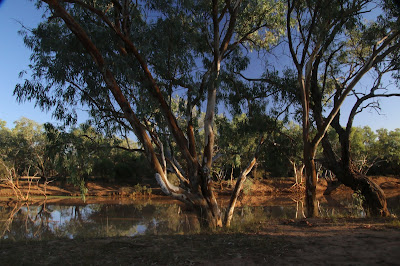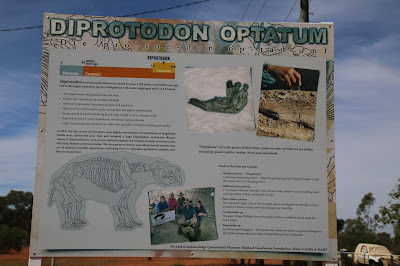Wednesday
6 April 2016 167 548 - 40°C
This
morning we were up and away as quickly as possible, heading to Eromanga. This is a small town with a mini oil
refinery. There is a Living History
Museum, which had a great video with lit accompanying displays for each section
of industry in the town and area – dinosaurs, oil and gas, opals and sheep, as
well as the school and CWA.

We then went
to the Eromanga Natural History Museum, which has been open three weeks and is
fantastic! I think this has the
potential, and the director has the passion, for this to become a major
regional attraction despite its remote location. The museum has been established to Queensland
Museum standards; and yet we could see and touch
real dinosaur bones! “Cooper” is the most complete skeleton, and is 4 to 6m
tall and 30m long. The staff are also
working on “George” who may be a larger version of “Cooper”. Cooper is a new
species and genus and is the largest species of dinosaur found in Australia to
date. The first piece was found by the
then fourteen-year-old son of the museum curator, and taken to Queensland
Museum for examination because it “looked interesting”. We got to see a video of how they prepare the
bones in the field with plaster casts and then got to see them working on the
rock/bones in the laboratory. www.enhm.com.au/
 |
| Dinosaur big toe |
 |
| Plaster covered fossils yet to be worked on |
 |
| Removing the rock from around the bone |
 |
| Bone encased in rock |
Next,
we drove through some very dry countryside where the road appeared to go
forever. I hit a small bird with the windscreen and twice Drew had to brake to
avoid hitting emus crossing the road. In
all our travel today, we saw six cars.
Next stop was Thargomindah, where we had a look at the third hydropower
plant built in the world (after London and Paris), which was driven by the
pressure of the Artesian Bore water. In
Thargomindah people have cooling tanks for water instead of hot water systems. The water comes out of the ground at 70°C and
needs to be cooled for use. We did not
get to see it operating as it was closed for a funeral in town.
www.visitbulloo.com.au/hydro-power-plant
Lake Bindegolly
National Park was our next stop. We had
planned to the stay the night here, however it was HOT and DRY, hardly any
lake, and VERY MANY FLIES. So, we
decided against the walk and this as a camping spot.
We continued toward Eulo, and stopped at the
Paroo River bush camping area (off grid). Lessons we learnt: always bring
bug spray, need a second small fan for Hayden, need 12V power point plug to
multiple cigarette lighter plug for fans, Waeco, lights and inverter, and need
a cigarette lighter plug with thick cables for the inverter, need to cover all
vents against bugs. We had a very early
night as the lights just attracted MILLIONS of bugs! Great to test out our setup off grid though.


















































